Numerical Investigation of Copper-Water (Cu-Water) Nanofluid with Different Shapes of Nanoparticles in a Channel with Stretching Wall: Slip Effects
Abstract
:1. Introduction
2. Mathematical Formulation
3. Numerical Solution
4. Results and Discussion
5. Conclusions
- The heat transfer rate increases by enhancing in the strength of solid volume fraction to
- The stretching Reynolds number decreases the velocity profile near the lower wall of the channel for spherical and cylindrical shape of nanoparticles.
Acknowledgments
Author Contributions
Conflicts of Interest
Abbreviations
| External uniform magnetic field | |
| Pressure (Pa) | |
| Thermal conductivity of the solid fraction (W/m·K) | |
| Thermal conductivity of the nanofluid (W/m·K) | |
| Density of the solid fraction (Kg/m3) | |
| Specific heat of nanofluid | |
| Fluid temperature (K or °C) | |
| Injection/suction | |
| Thermal conductivity of the fluid (W/m·K) | |
| Thermal conductivity of the nanofluid (W/m·K) | |
| Shape factor through H-C Model | |
| Specific heat at constant pressure (J/kg·K) | |
| Velocity component in Cartesian coordinate | |
| Greek symbols | |
| Scaled boundary layer coordinate | |
| Effective electrical conductivity of nanofluid (S.m-1) | |
| Dynamic viscosity | |
| Self-similar temperature | |
| Nanoparticle volume fraction parameter | |
| Effective dynamic viscosity of nanofluid | |
| Density (kg/m3) | |
| Dimensionless numbers | |
| Stretching Reynolds number | |
| Prandtl number | |
| Density of the nanofluid | |
| Magnetic parameter | |
| Dynamic viscosity of the nanofluid (Pa·s) | |
| Ratio of effective electrical conductivity of nanofluid to the base fluid | |
| Subscripts | |
| Nanofluid | |
| Solid phase | |
| Upper wall | |
| Fluid phase | |
| Lower wall |
References
- Maxwell, J.C. Electricity and Magnetism, 3rd ed.; Clarendon Press: Oxford, England, UK, 1904. [Google Scholar]
- Hamilton, R.L.; Crosser, O.K. Thermal conductivity of heterogeneous two component systems. Ind. Eng. Chem. Fundam. 1962, 1, 187–191. [Google Scholar] [CrossRef]
- Wasp, E.J.; Kenny, J.P.; Gandhi, R.L. Solid-Liquid Flow Slurry Pipeline Transportation; Series on Bulk Materials Handling; Trans. Tech. Publications: Clausthal, Germany, 1977; Volume 1. [Google Scholar]
- Choi, S.U.S.; Eastman, J.A. Enhancing thermal conductivity of fluids with nanoparticle. In Developments and Applications of Non-Newtonian Flows, ASME International Mechanical Engineering Congress & Exposition, San Francisco, CA, USA, 12–17 November 1995; Siginer, D.A., Wang, H.P., Eds.; pp. 99–105.
- Choi, S.U.S.; Zhang, Z.G.; Yu, W.; Lockwood, F.E.; Grulke, E.A. Anomalously thermal conductivity enhancement in nanotube suspensions. App. Phys. Lett. 2001, 79, 2252–2254. [Google Scholar] [CrossRef]
- Buongiorno, J. Convective transport in nanofluids. J. Heat Transfer 2006, 128, 240–250. [Google Scholar] [CrossRef]
- Sarkar, J. A critical review on convective heat transfer correlations of nano- fluids. Renew. Sust. Energ. Rev. 2011, 15, 3271–3277. [Google Scholar] [CrossRef]
- Keblinski, P.; Phillpot, S.R.; Choi, S.U.S.; Eastman, J.A. Mechanisms of heat flow in suspensions of nano-sized particles (nanofluids). Int. J. Heat Mass Transfer 2002, 45, 855–863. [Google Scholar] [CrossRef]
- Heris, S.Z.; Esfahany, M.N.; Etemad, S.G. Experimental investigation of convective heat transfer of Al2O3/water nanofluid in circular tube. Int. J. Heat Fluid Flow 2007, 28, 203–210. [Google Scholar] [CrossRef]
- Pak, B.C.; Cho, Y.I. Hydrodynamic and heat transfer study of dispersed fluids with submicron metallic oxide particles. Exp. Heat Transfer 1998, 11, 151–170. [Google Scholar] [CrossRef]
- Sommers, A.D.; Yerkes, K.L. Experimental investigation into the convective heat transfer and system-level effects of Al2O3-propanol nanofluid. J. Nanopart. Res. 2010, 12, 1003–1014. [Google Scholar] [CrossRef]
- Wen, D.S.; Ding, Y.L. Experimental investigation into convective heat transfer of nanofluids at the entrance region under laminar flow conditions. Int. J. Heat Mass Transfer 2004, 47, 5181–5188. [Google Scholar] [CrossRef]
- Xuan, Y.M.; Li, Q. Investigation on convective heat transfer and flow features of nanofluids. J. Heat Transfer 2003, 125, 151–155. [Google Scholar] [CrossRef]
- Fard, M.H.; Esfahany, M.N.; Talaie, M.R. Numerical study of convective heat transfer of nanofluids in a circular tube two-phase model versus single-phase model. Int. Commun. Heat Mass Transfer 2010, 37, 91–97. [Google Scholar] [CrossRef]
- Kuznetsov, A.V.; Nield, D.A. Natural convective boundary layer flow of a nanofluid past a vertical plate. Int. J. Therm. Sci. 2010, 49, 243–247. [Google Scholar] [CrossRef]
- Sheikholeslami, M.; Ashorynejad, H.R.; Domairry, G.; Hashim, I. Flow and heat transfer of Cu-water nanofluid between a stretching sheet and a porous surface in a rotating system. J. Appl. Math 2012. [Google Scholar] [CrossRef]
- Raza, J.; Rohni, A.M.; Omar, Z. A Note on Some Solutions of Copper-Water (Cu-Water) Nanofluids in a Channel with Slowly Expanding or Contracting Walls with Heat Transfer. Math. Comput. Appl. 2016, 21. [Google Scholar] [CrossRef]
- Domairry, D.; Sheikholeslami, M.; Ashorynejad, H.R.; Subba, R.; Gorla, R.; Khani, M. Natural convection flow of a non-Newtonian nanofluid between two vertical flat plates. J. Nanomater. Nanoeng. Nanosyst. 2012, 225, 115–122. [Google Scholar] [CrossRef]
- Raza, J.; Rohni, A.M.; Omar, Z. MHD flow and heat transfer of Cu-water nanofluid in a semi porous channel with stretching walls. Int. J. Heat Mass Transfer 2016, 103, 336–340. [Google Scholar] [CrossRef]
- Sheikholeslami, M.; Rashidi, M.M.; Ganji, D.D. Numerical investigation of magnetic nanofluid forced convective heat transfer in existence of variable magnetic field using two phase model. J. Mol. Liq. 2015, 212, 117–126. [Google Scholar] [CrossRef]
- Sheikholeslami, M.; Ganji, D.D. Nanofluid flow and heat transfer between parallel plates considering Brownian motion using DTM. Comput. Methods Appl. Mech. Eng. 2015, 283, 651–663. [Google Scholar] [CrossRef]
- Sheikholeslami, M.; Ganji, D.D.; Javed, M.Y.; Ellahi, R. Effect of thermal radiation on magnetohydrodynamics nanofluid flow and heat transfer by means of two phase model. J. Magn. Magn. Mater. 2015, 374, 36–43. [Google Scholar] [CrossRef]
- Freidoonimehr, N.; Rashidi, M.M.; Mahmud, S. Unsteady MHD free convective flow past a permeable stretching vertical surface in a nano-fluid. Int. J. Therm. Sci. 2015, 87, 136–145. [Google Scholar] [CrossRef]
- Akbar, M.Z.; Ashraf, M.; Iqbal, M.F.; Ali, K. Heat and mass transfer analysis of unsteady MHD nanofluid flow through a channel with moving porous walls and medium. AIP Advances 2016, 6, 045222. [Google Scholar] [CrossRef]
- Garoosi, F.; Jahanshaloo, L.; Rashidi, M.M.; Badakhsh, A.; Ali, M.E. Numerical simulation of natural convection of the nanofluid in heat exchangers using a Buongiorno model. Appl. Math. Comput. 2015, 254, 183–203. [Google Scholar] [CrossRef]
- Yu, S.; Ameel, T.A. Slip-flow heat transfer in rectangular microchannels. Int. J. Heat Mass Transfer 2001, 44, 4225–4234. [Google Scholar] [CrossRef]
- Watannebe, K.; Mizunuma, Y.H. Slip of Newtonian Fluids at Solid Boundary. JSME Int. J. Series B Fluids Therm. Eng. 1998, 41, 525–532. [Google Scholar] [CrossRef]
- Jain, S.R.; Sharma, P.K. Effect of Viscous Heating on Flow past a Vertical Plate in Slip-Flow Regime without Periodic Temperature Variations. J. Rajasthan Acad. Phys. Sci. 2006, 5, 383–398. [Google Scholar]
- Khaled, A.R.A.; Vafai, K. The Effect of the Slip Condition on Stokes and Couette Flows Due to an Oscillating Wall: Exact solutions. Int. J. Non-Linear Mech. 2004, 39, 759–809. [Google Scholar] [CrossRef]
- Hamilton, R.L.; Crosser, O.K. Thermal conductivity of heterogeneous two component systems. Ind. Eng. Chem. Fundam. 1962, 1, 187–191. [Google Scholar] [CrossRef]
- Meade, D.B.; Haran, B.S.; White, R.E. The shooting technique for the solution of two-point boundary value problems. Maple Tech. Newsl. 1996, 3, 1–8. [Google Scholar]
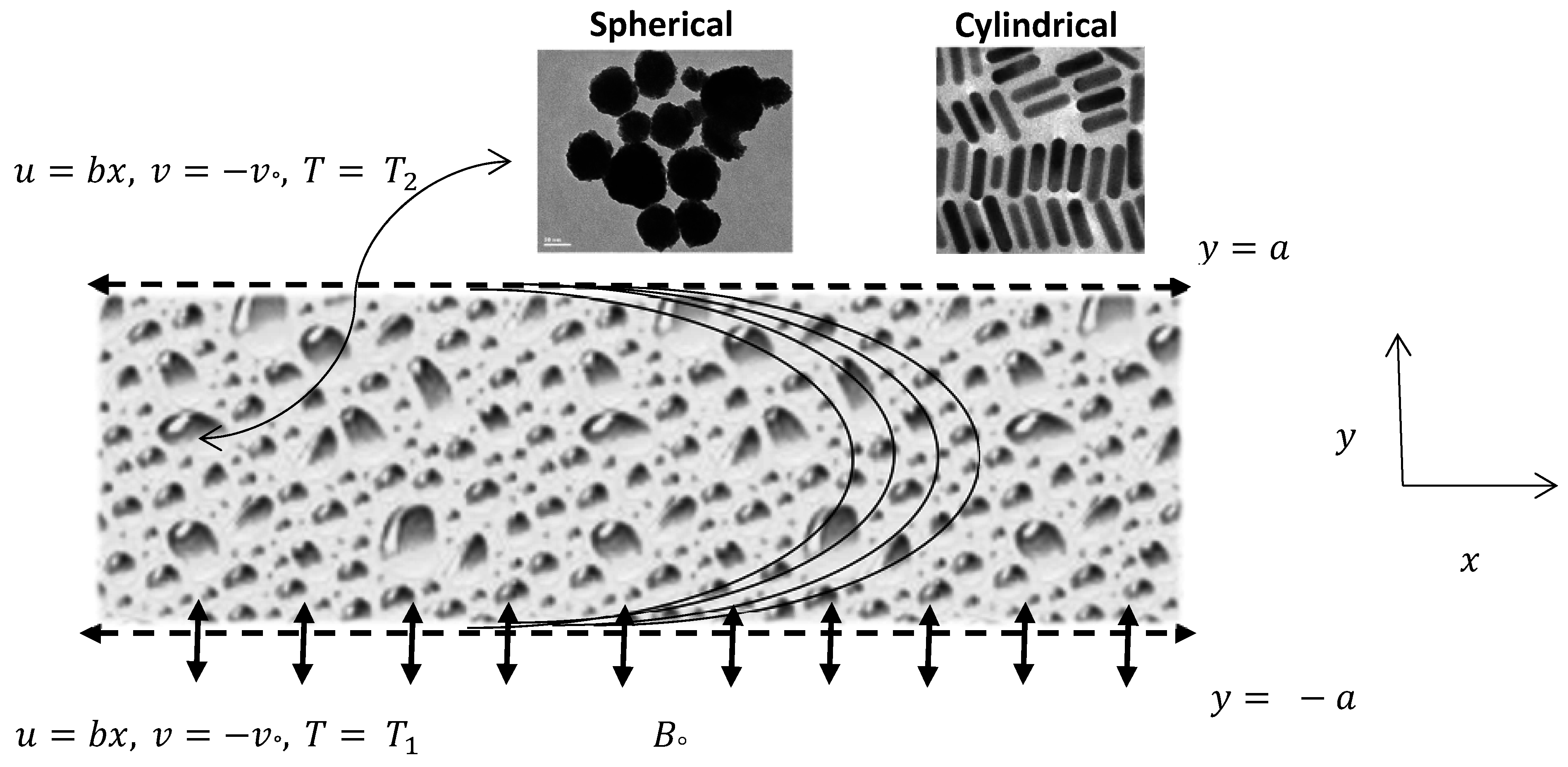
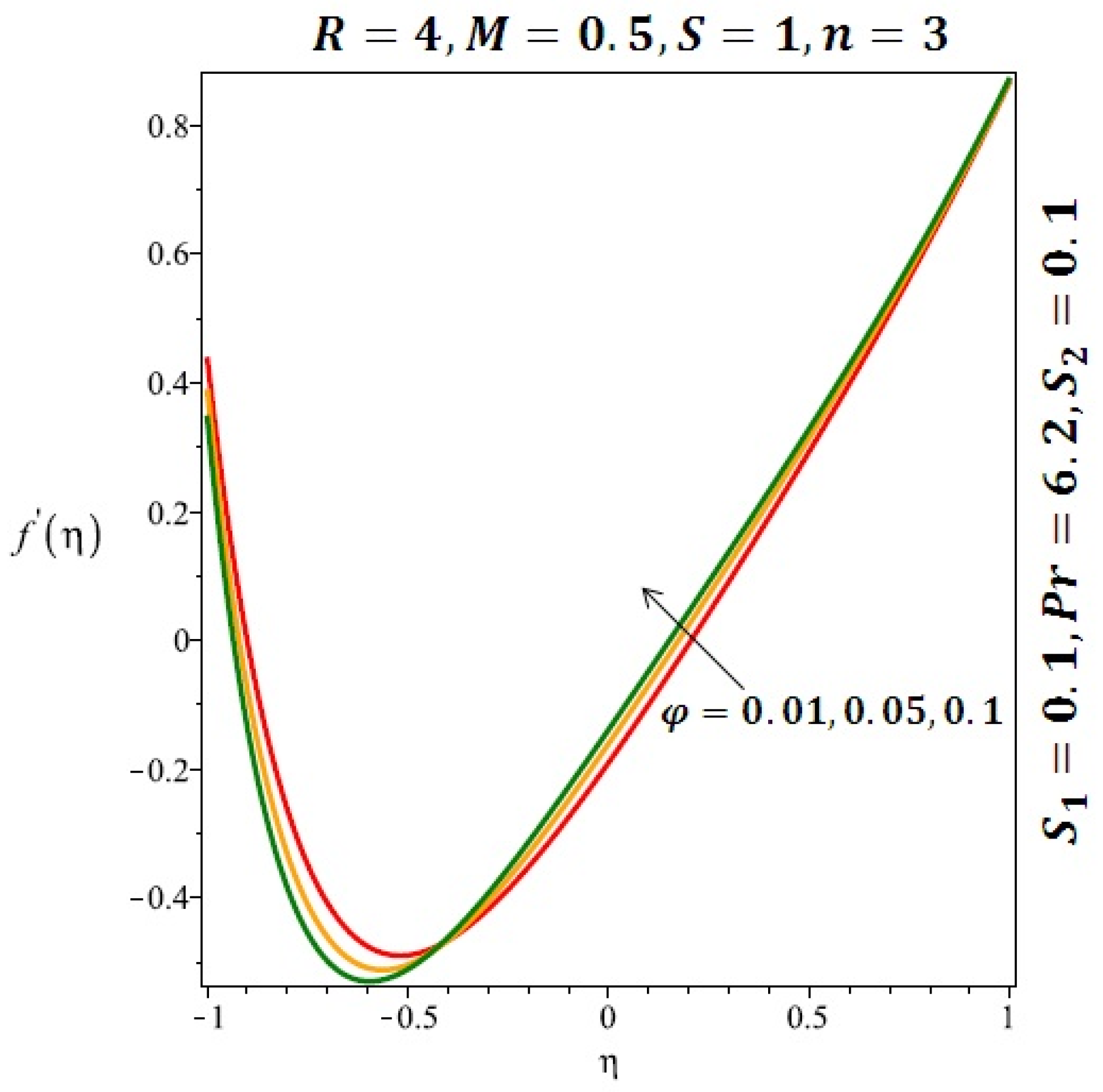
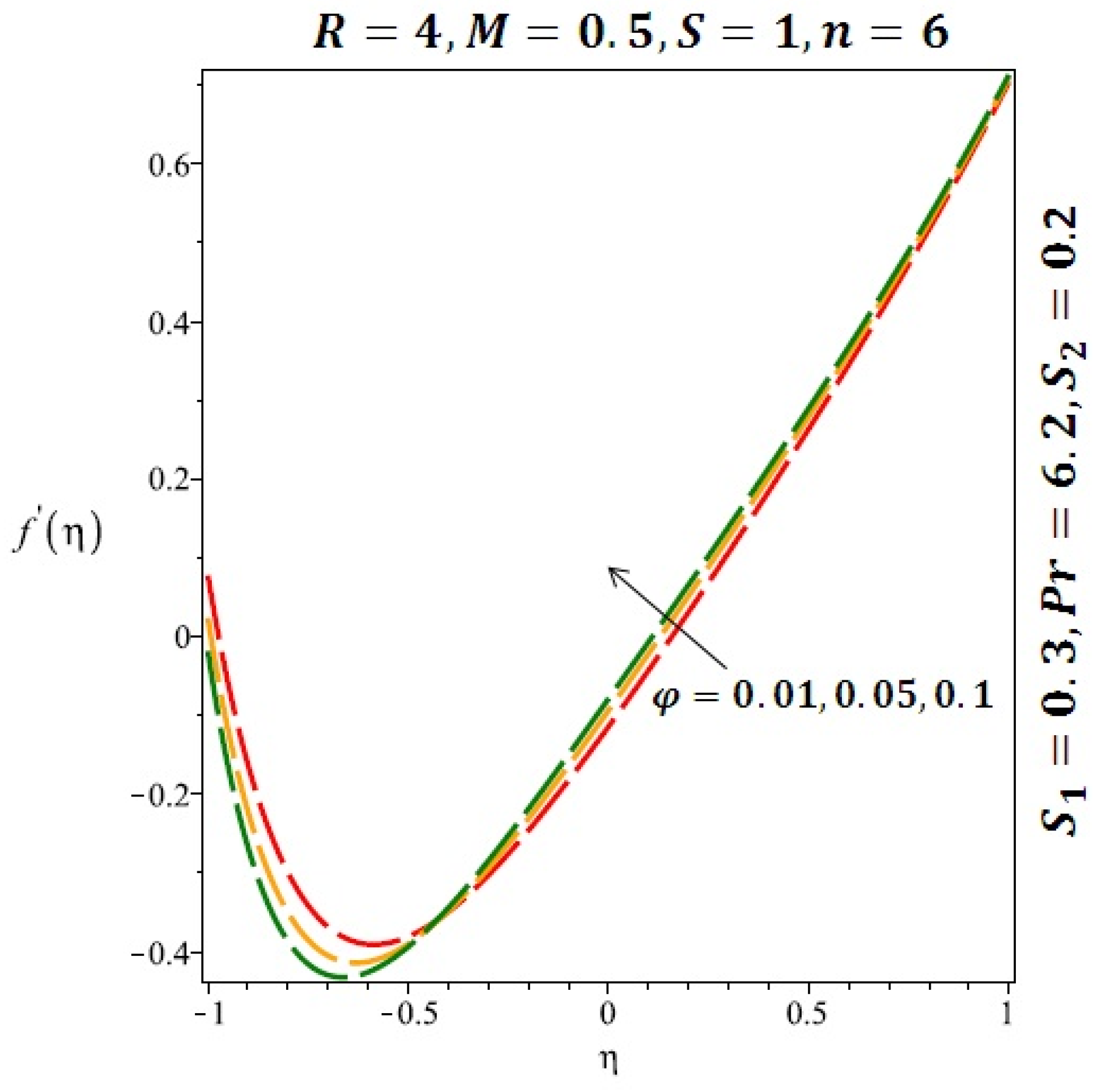

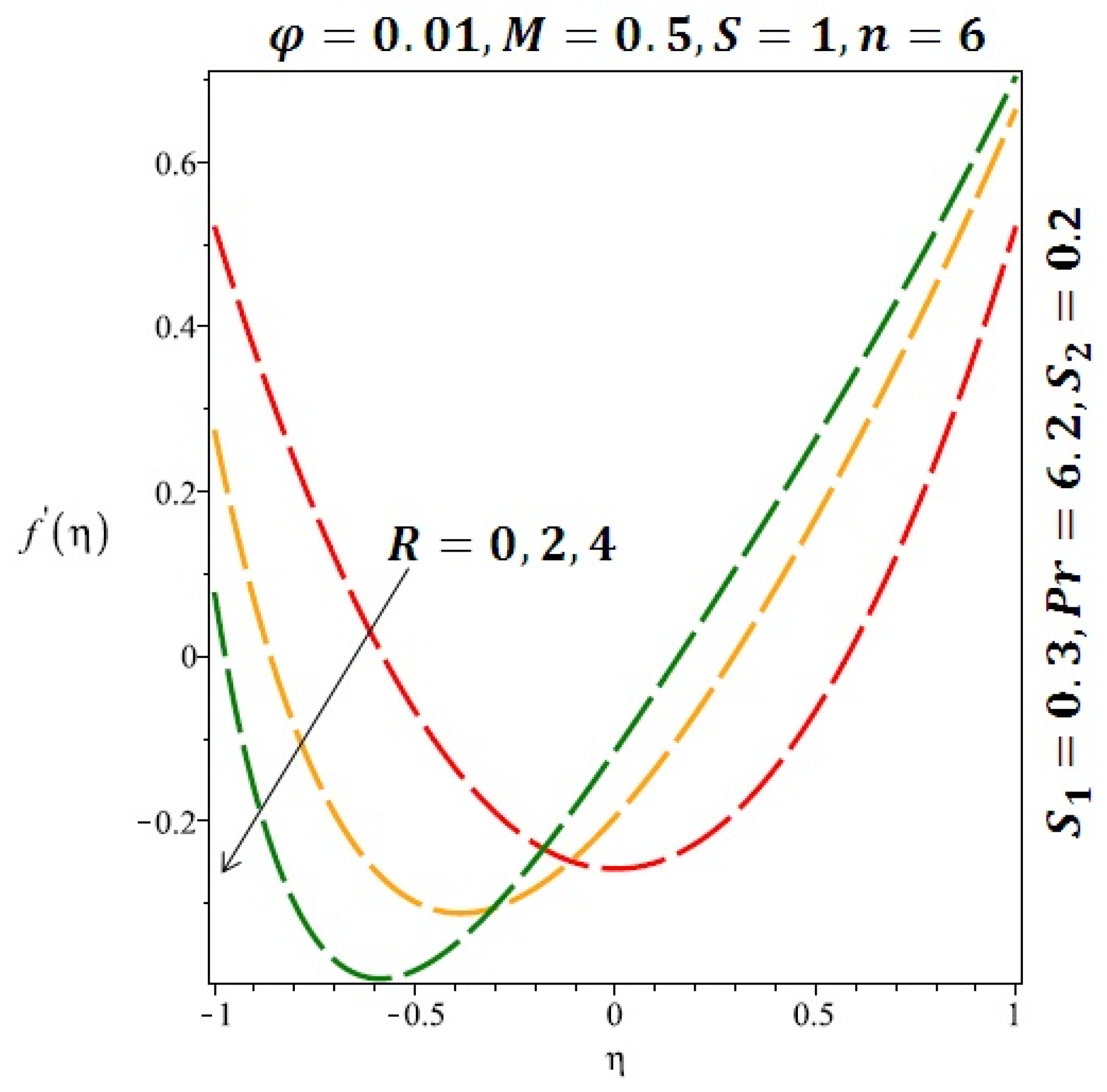
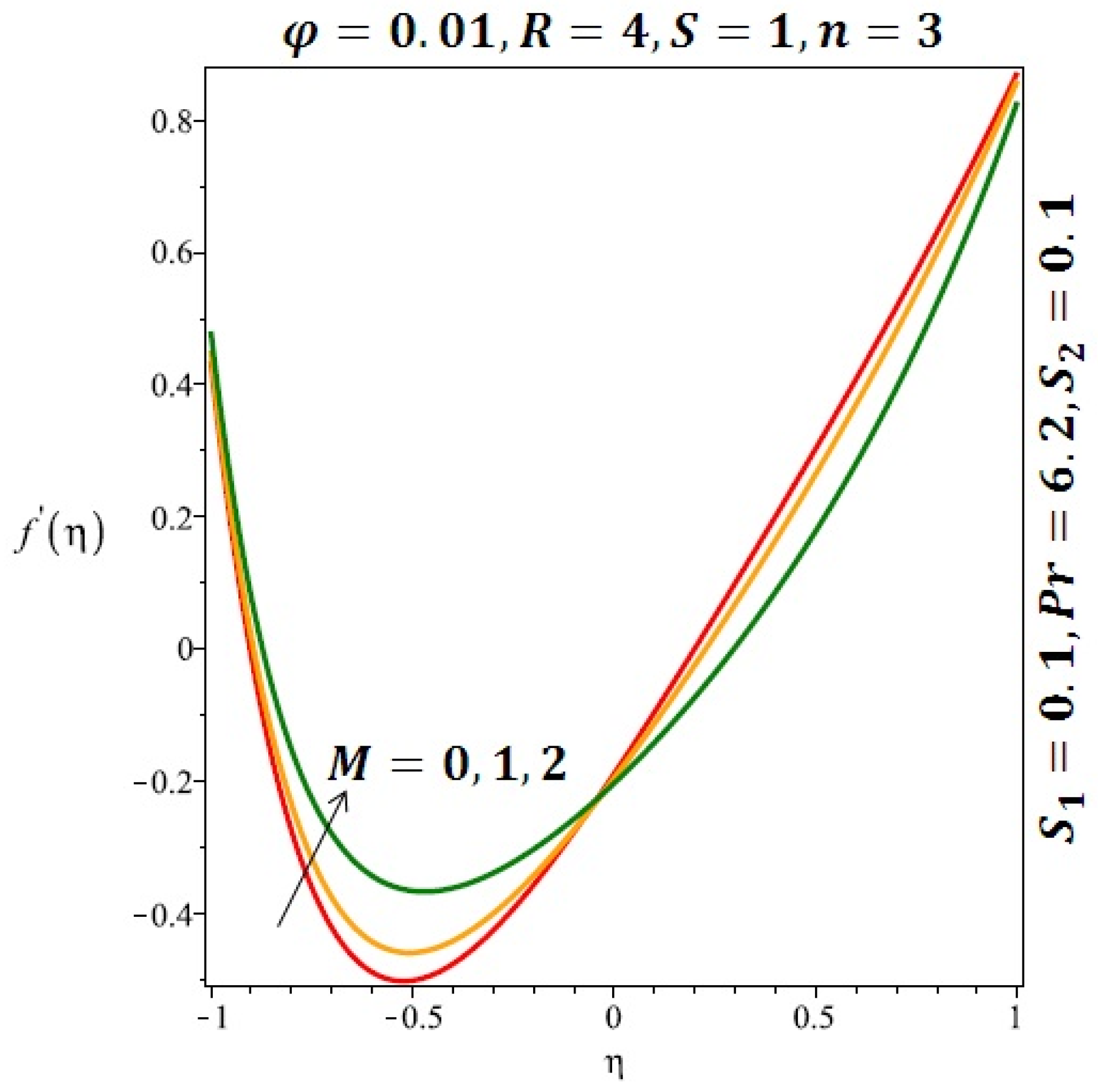

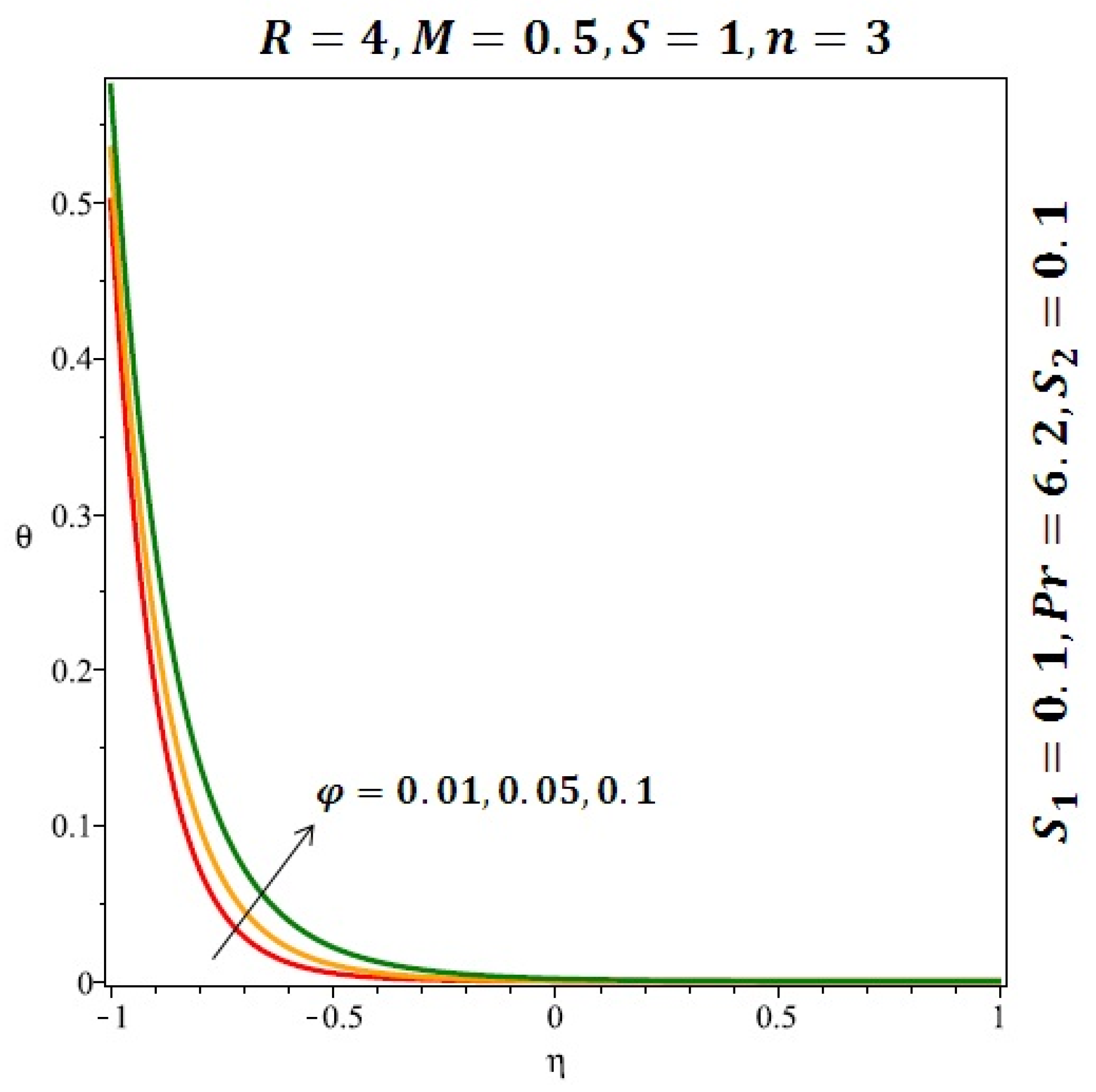
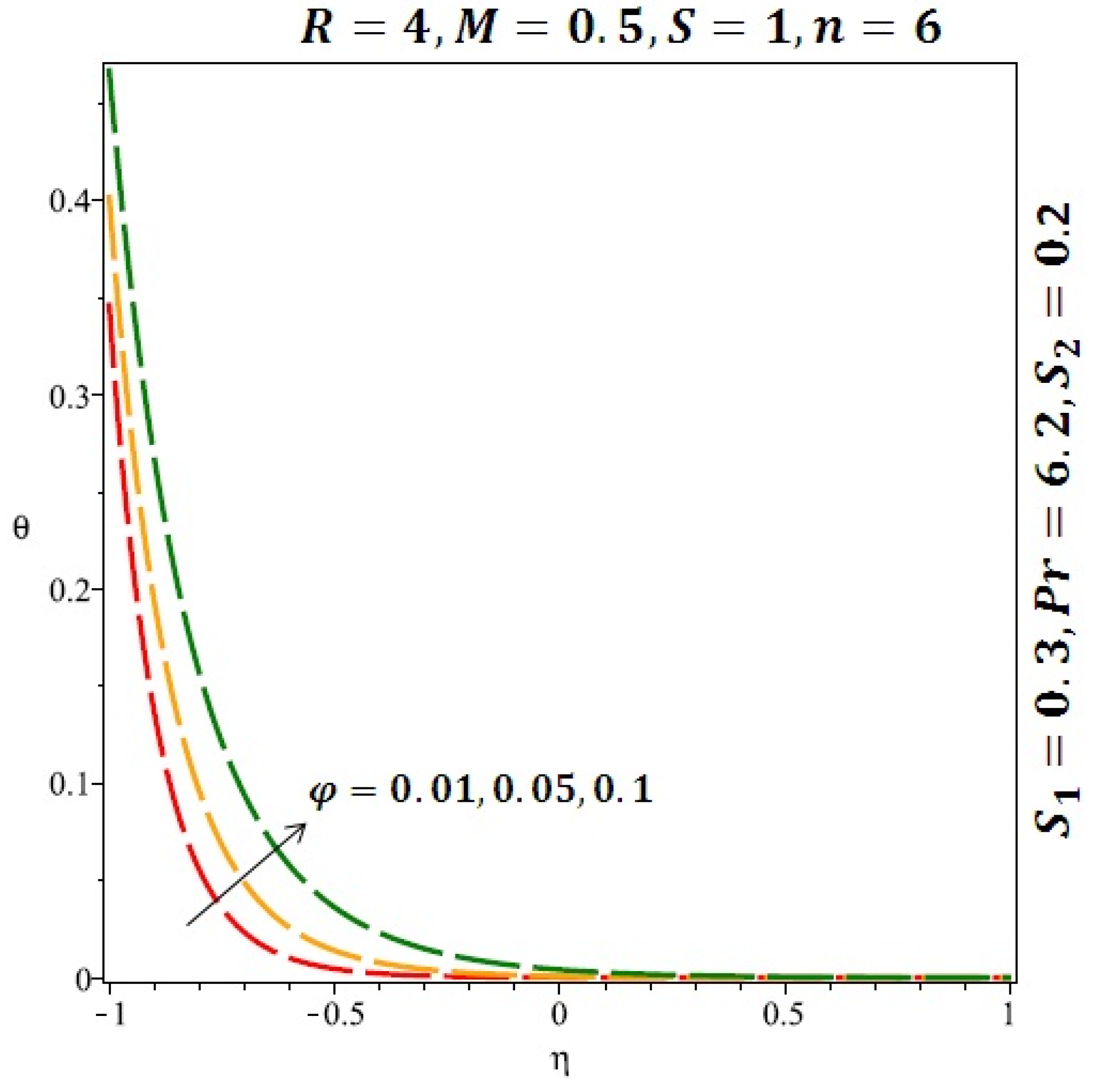


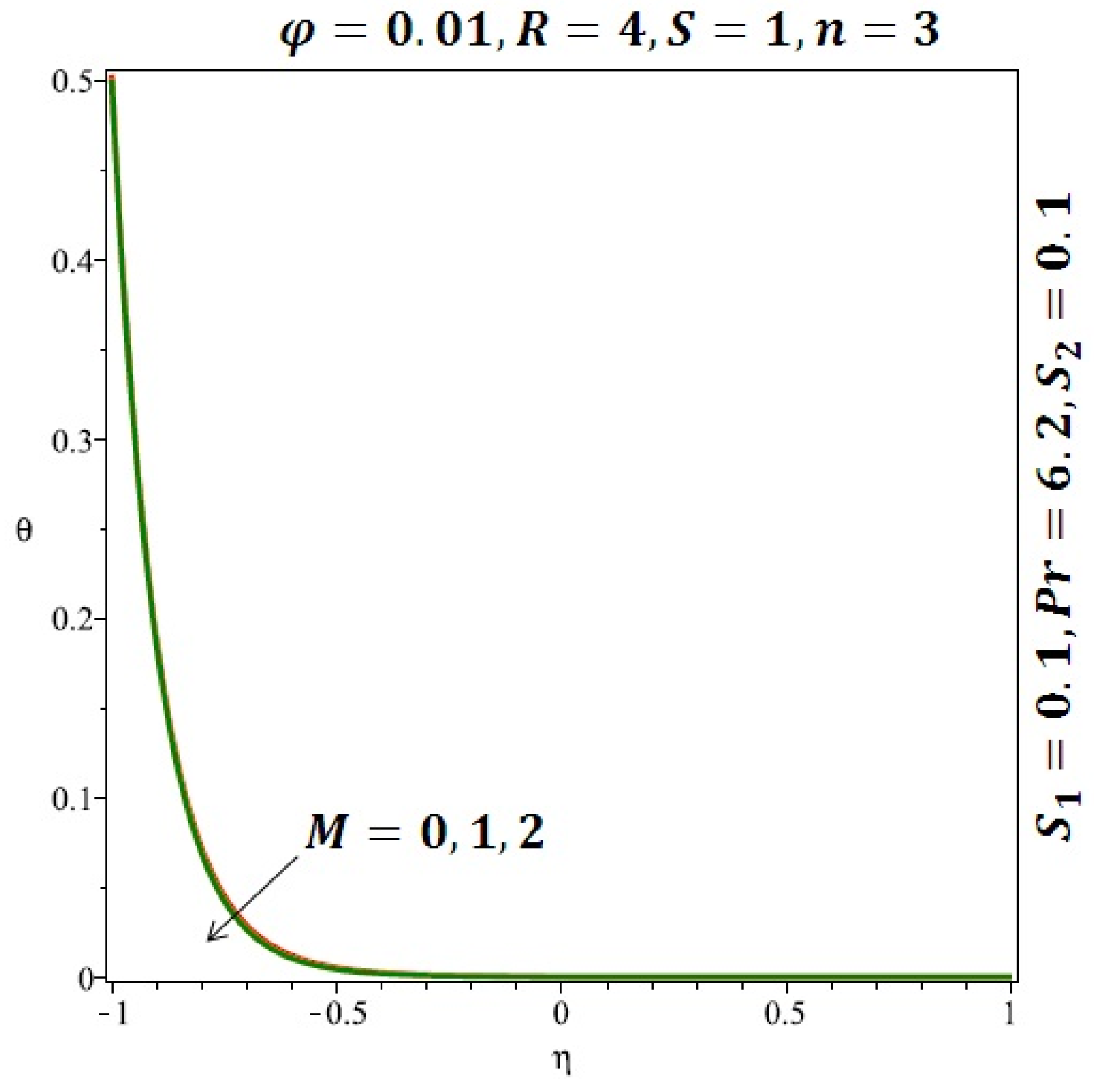
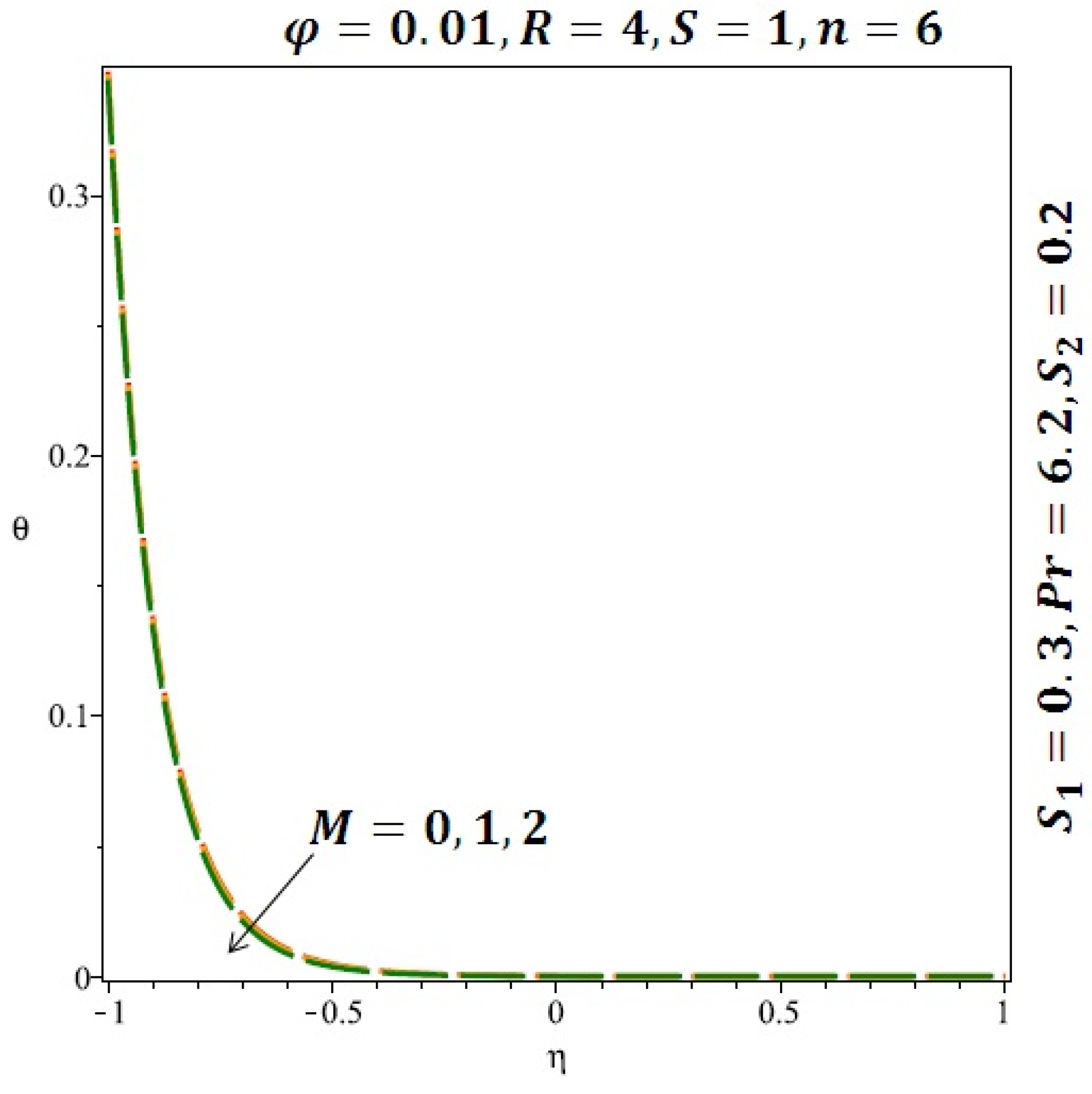
| Density ρ (kg/m3) | Specific heat at constant pressure (J/kg·K) | Thermal conductivity (W/m·K) | Electrical conductivity (S·m–1) | |
|---|---|---|---|---|
| Pure water | 991.1 | 4179 | 0.613 | 0.05 |
| Copper (Cu) | 8933 | 385 | 401 | |
| Alumina () | 3970 | 765 | 40 | |
| Silver (Ag) | 10500 | 235 | 429 | |
| Titanium Oxide | 4250 | 686.2 | 8.9538 |
| Solid Volume Fraction | Magnetic Parameter | Reynolds Number | Suction Parameter | Velocity Slip Condition | Thermal Slip Condition | Heat transfer Rate |
|---|---|---|---|---|---|---|
| 0.01 | 0.5 | 4 | 1 | 0.1 | 0.1 | -4.964682800390394 |
| 0.03 | -4.795613667915525 | |||||
| 0.05 | -4.629249877087038 | |||||
| 0.1 | -4.225974478882998 |
| Solid Volume Fraction | Magnetic Parameter | Reynolds Number | Suction Parameter | Velocity Slip Condition | Thermal Slip Condition | Heat transfer Rate |
|---|---|---|---|---|---|---|
| 0.01 | 0.5 | 4 | 1 | 0.3 | 0.2 | -3.2951491963380715 |
| 0.03 | -3.218220931297281 | |||||
| 0.05 | -3.141039169488954 | |||||
| 0.1 | -2.947344452998095 |
© 2016 by the authors; licensee MDPI, Basel, Switzerland. This article is an open access article distributed under the terms and conditions of the Creative Commons Attribution (CC-BY) license (http://creativecommons.org/licenses/by/4.0/).
Share and Cite
Raza, J.; Rohni, A.M.; Omar, Z. Numerical Investigation of Copper-Water (Cu-Water) Nanofluid with Different Shapes of Nanoparticles in a Channel with Stretching Wall: Slip Effects. Math. Comput. Appl. 2016, 21, 43. https://doi.org/10.3390/mca21040043
Raza J, Rohni AM, Omar Z. Numerical Investigation of Copper-Water (Cu-Water) Nanofluid with Different Shapes of Nanoparticles in a Channel with Stretching Wall: Slip Effects. Mathematical and Computational Applications. 2016; 21(4):43. https://doi.org/10.3390/mca21040043
Chicago/Turabian StyleRaza, Jawad, Azizah Mohd Rohni, and Zurni Omar. 2016. "Numerical Investigation of Copper-Water (Cu-Water) Nanofluid with Different Shapes of Nanoparticles in a Channel with Stretching Wall: Slip Effects" Mathematical and Computational Applications 21, no. 4: 43. https://doi.org/10.3390/mca21040043





